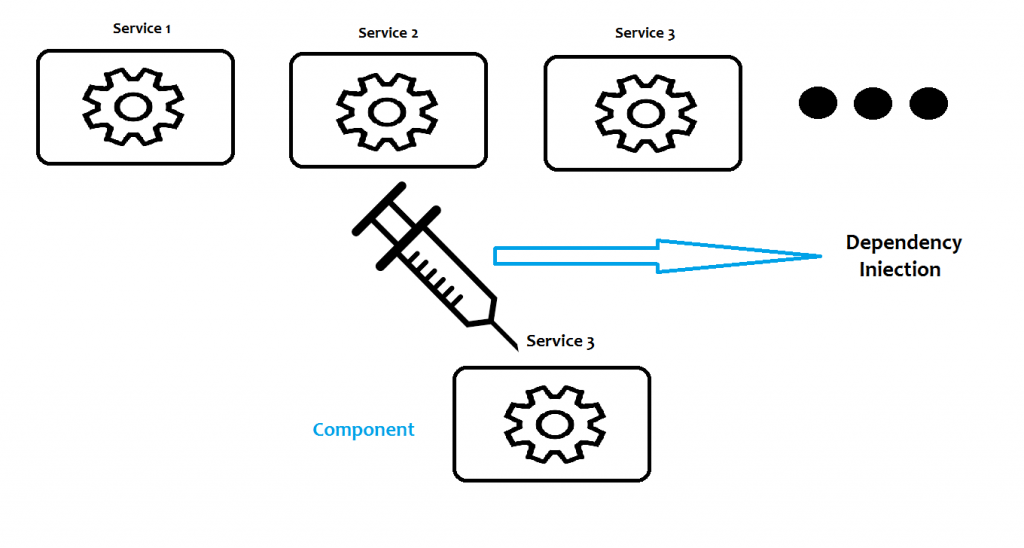在開發專案時你一定會使用到 Service 的技巧,Service 是一個廣泛的類別,包括 app 所需要的任何功能、數據或特性,而通常一個 service 是一個具有狹窄且明確定義目的的 class,簡單來説可以想像成一個 service 只會對一個明確的目的提供所以有服務。
Angular 將 component 與 service 拆分開以增加模塊化與可重用性,將處理 component view 的功能與其他類型的功能拆發開來可以讓你在開發 component 時更精簡高效,所以理想的情況下 component 中的邏輯只用來處理使用者的操作,component 應該提供 property binding 的 property 與 event binding 的 method 僅此而已。
而較為複雜的邏輯任務就應該委託給 service,比如從 server 中獲取數據、驗證用戶輸入或直接登陸到控制台等等複雜的邏輯處理都應該在 service 中處理掉,將這些複雜的邏輯寫在 service 中就可以讓他們被任何 component 使用。
不過說了這麼多,其實 Angular 是不強制你做這些動作的,不過建議再開發大型專案時還是將複雜的邏輯從 component 中移到 service 中,保持你的 component 單純乾淨也讓 service 可以透過 inject 提供給其他 component 使用。

dependency injection 可以簡單地稱為 DI ,它是一種設計模式 當你要使用一個 class 時,可以直接從外部來源請求而不是像傳統的做法將它實例化,它存在於整個 Angualr 中,他可以讓你的程式保持靈活、可測試與彈性,component 可以在不知道如何創建 service class 的情況下使用到它的內容,簡單來說 DI 讓使用者可以不用去了解提供者的一些不重要的信息。
介紹玩什麼事 DI 後,接著來做一個小小的例子,這是再開發專案時基本上都會遇到的
首先利用 Angular CLI 建立一個 service
ng generate service project
ng g s project
打開 project.service.ts
import { Injectable } from '@angular/core';
@Injectable({
providedIn: 'root'
})
export class ProjectService {
constructor() { }
}
首先看到的是這個檔案使用了 @Injectable() 將這個 class 裝飾成 Angualr 可以在 DI 系統中使用的,接著可以看到在他的 matedata 中定義了 provideIn: 'root' 這代表這個 service 在整個 app 都是可以被使用的,如果不指定 provideIn 的話在 component 中將無法直接注入到 component 中,舉個例子
import { Injectable } from '@angular/core';
@Injectable()
export class ProjectService {
constructor() { }
}
上面的 service 沒有在 metadata 中設定 providedIn,這個情況下如果跟平常一樣在 component 中注入這個 service 就會出錯
import { Component, OnInit } from '@angular/core';
import { ProductService } from '../../second/product.service';
@Component({
selector: 'app-third',
templateUrl: './third.component.html',
})
export class ThirdComponent implements OnInit {
constructor(private productService: ProductService) {} // (1)
ngOnInit(): void {
console.log(this.productService.getName()); // (2)
}
}

在 console 中就會看到這個錯誤,代表他找不到 ProductService 這個 provider 可以注入到 component 中,要解決這個問題需要在 component 的 metadata 中添加 providers 這個 property 並將要注入的 service 放進去這樣就可以正常使用了
import { Component, OnInit } from '@angular/core';
import { ProductService } from '../../second/product.service';
@Component({
selector: 'app-third',
templateUrl: './third.component.html',
providers: [ProductService]
})
export class ThirdComponent implements OnInit {
constructor(private productService: ProductService) { }
ngOnInit(): void {
console.log(this.productService.getName());
}
}
最後要將 service 注入到 component 中,雖然上面已經用了不過還是講一下,要注入 service 到 component 中,要在 component 的 constructor 中將它注入,這要就可以在這個 component 中使用這個 service 提供的服務
import { Component, OnInit } from '@angular/core';
import { ProductService } from '../../second/product.service';
@Component({
selector: 'app-third',
templateUrl: './third.component.html',
providers: [ProductService]
})
export class ThirdComponent implements OnInit {
constructor(private productService: ProductService) { } // (1)
ngOnInit(): void {
console.log(this.productService.getName());
}
}
本章中介紹了如何建立一個 service 並使用 dependency injection 將它注入到 component 中,雖然也介紹了什麼是 dependency injection,不過 DI 的觀念比上面介紹的在複雜更多,比如說 @Injestable() 中的 metadata providedIn 就可以填入 root、module name 或 any 填入每個值都有對應不同的使用場景,其中的關係有點複雜就不在本篇章中介紹,一方面是我也不是非常了解不敢隨便分享怕分享了錯誤的資訊,等之後我在摸熟一點會再開一個系列講解這方面的資訊,所以這邊就大概介紹基本的觀念而已![]() 。
。
下一篇將會介紹上面有提到的內容,當 @Injestable 沒有設定 providedIn 時需要在 component 的 metadata 中添加 providers 這個其實是個縮寫,詳細內容就明天再仔細講解吧,那就明天見!
